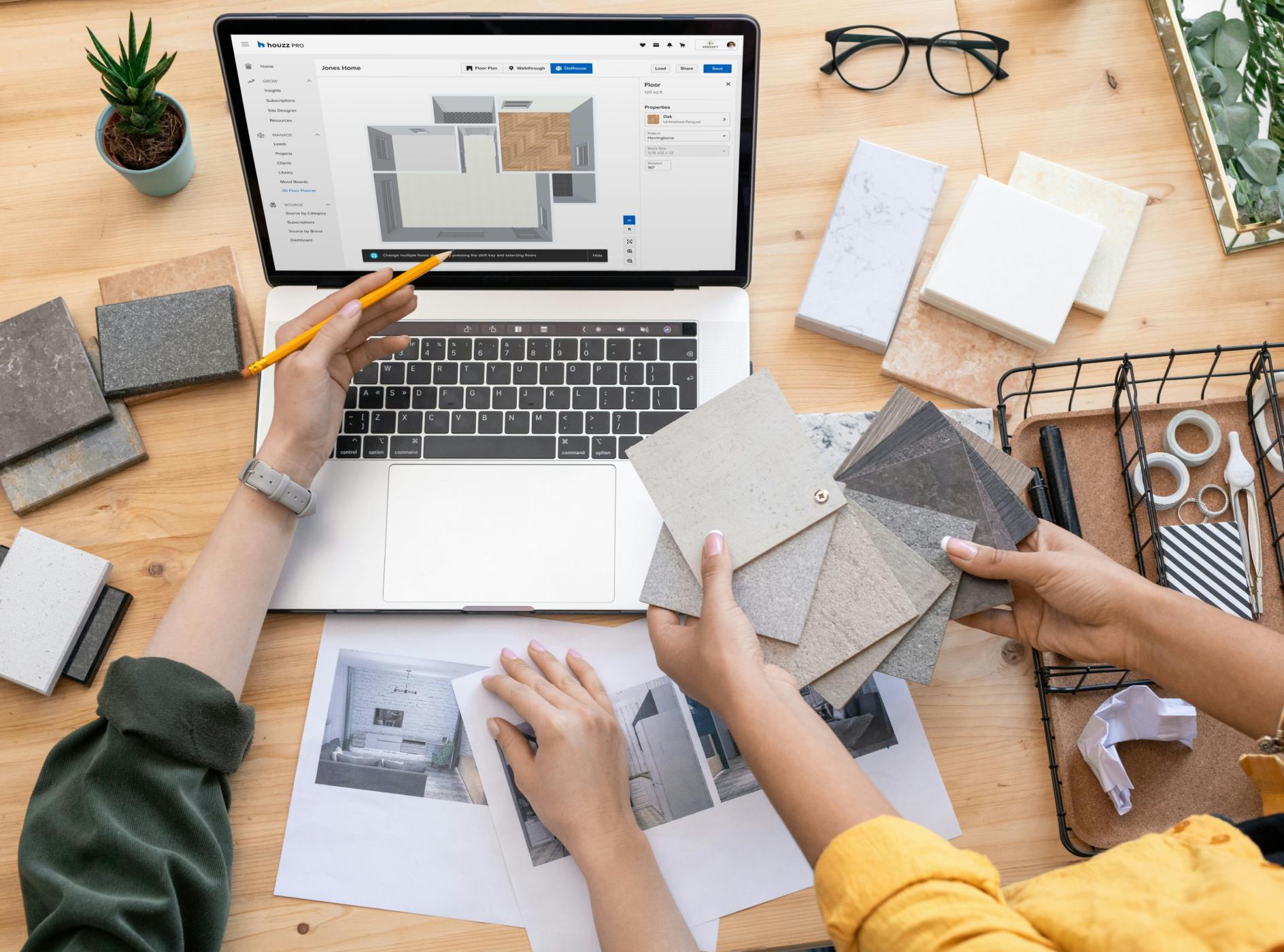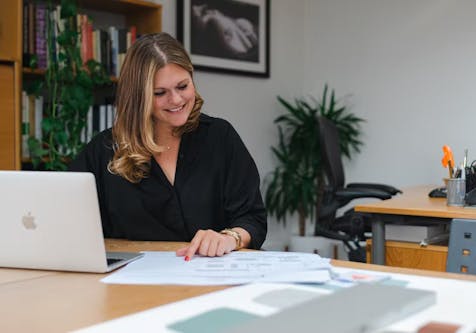17 Questions to Ask Potential Clients on the Discovery Call
Get all the info you need and put your best foot forward by knowing what to discuss from the get-go

Your first phone call or meeting with a potential client is about more than just presenting your own experience and ideas for consideration. It’s a chance to evaluate whether the person is a good fit for you in terms of personality, communication style, expectations and more. To help guide your conversation so you can make well-informed decisions, we’ve come up with 17 questions to ask potential design or construction clients. Together, they’ll give you a thorough sense of whether you’ll enjoy working with the person and feel good about the project, or if you should save your valuable time and energy for something that’s a better fit.

The Basics
Before you even discuss any design details, it’s helpful to get some general info. The client’s answers to these might make it clear right away whether a project might not work for you, in which case you’ll save yourself a lot of time and effort.
1. Have you worked with a renovation professional before, and if so, how long ago?
Someone who’s been around the renovation block will tend to have much more realistic project expectations in general. If it’s the first time, you’ll likely have to educate the client on certain aspects as you go. Similarly, if it’s been a while, the client might not know how much has changed in the world of renovation, particularly regarding pricing.
“Clients a lot of times are clueless on the design process in general,” interior designer Katie Rainey says. “They just know they need help.”
“Remodeling a kitchen or a bathroom is not what it looked like years ago,” interior designer Jennifer Kizzee says. “Prices have increased substantially, and timelines are a lot longer now than they were before. But a lot of people have high expectations and low budgets.”
2. What timeline do you have in mind?
If it works with your project load, great. If not, you’ll save yourself stress by either working out a different timeline or passing on the project entirely. If the person has a hard deadline because a wedding or other event will be held at the house, it’s good to know about that too.
“If we cannot take on a project at a client’s preferred time frame, we are very upfront about it,” says Susan Heinz, whose firm focuses on residential contracting. “Being transparent may mean that a client sometimes moves on. While no one ever wants to lose a job, sometimes it’s best for everyone. If we try to accommodate a schedule for a job that we know we cannot follow through on, we are setting everyone up for failure and disappointment.”
“For clients that I really want or think would be a good fit, but we don’t have capacity right there and then, I try to see if they’ll wait for us. Or I’ll give them a time frame if they want to push the job out further,” interior designer Karen Wolf says. “And I’ll always do this very politely.”
Tip: Use software with a scheduling feature to keep projects on track, one that lets the client check on scheduling details. For instance, Houzz Pro’s “Schedule feature is just amazing,” Heinz says. “We used to use a different software before that was just cumbersome. Now clients can see exactly how their project is progressing: ‘Oh, this is what you’re doing this week on my project,’ [and we can] see which trade we have scheduled. It is really nice that you can get as detailed and granular as you want with the ability to add notes and schedule specific arrival times.”
3. What’s your budget?
You want clients who “are not afraid to spend the money they need to achieve the vision,” interior designer Jonathan Gordon says. “It is much better to know that you have the ability to create within guidelines that support what they want for their spaces. It’s just ideal all around.”
Along with allowing you to achieve the client’s vision, a realistic budget lets you do your best work without having to constantly figure out how to cut corners. And if you have an ideal budget or minimum amount in mind, don’t be afraid to stick to it even if it’s tempting to do otherwise.
“We now have an established project minimum and intently focus on the clients that value the turnkey service and elevated standard that we offer,” says interior designer Nicole Arnold, whose firm has won 13 consecutive Best of Houzz awards. “These are the types of projects we do best; since we’re in charge of the whole project, we can best control the results. It’s been an intentional marketing shift for our business that’s really paid off.”
4. Where is the project located?
It’s important to factor in travel time if the client expects you to be on-site regularly. Some designers decide based on mileage; others go by the expected actual commuting time with traffic.
“One of the big things we ask is where they are located,” custom-home builder Jenny Sneller says. “There are certain neighbourhoods that we’ll take almost any job because we want to grow in that area of town, while other areas that are further out might be a stretch.”
Despite getting leads from all over Rhode Island, renovation pro Mike Biestek limits his business service to six towns. “Anything outside of that, we typically turn down,” he says. This helps keep his project load manageable and allows him to empower his team so he can step back from the day-to-day when needed.

The Home and Design
Once you’ve established that all of the above responses work for you, it’s time to learn more about the client’s current space and vision for the new design.
5. Is this your personal residence or an investment property?
If the client lives in the home, the approach will likely be very different than if they’ll be using it as a rental or looking to flip it. “Generally, investors want the process to be more streamlined and homeowners want to be more involved,” says Robert Frank, whose firm provides a wide range of design services, including historic building conservation.
6. How long have you owned the home?
This can give you a better sense of how likely the client is to pursue a space makeover versus just gathering information for some undetermined time in the future. “Customers who recently purchased a home are more apt to pull the trigger on a renovation project,” builder Eric Payne says.
7. What about your space does and doesn’t work for you currently?
Sometimes clients focus more on aesthetics and less on functionality, but functionality is what will truly help them enjoy the space and use it to the fullest. In fact, interior designer and home stager Ann Bridgman doesn’t just take into account what the client says; for the next step, the site visit, “I ask them not to clean their house for me,” she says. “This can actually alert me to functional issues in the home I may be able to solve.”
8. What design styles and aesthetics are you drawn to?
While every good designer or builder can executive the client’s own vision instead of just superimposing his or her own style preferences on the client’s space, it’s helpful to know if something is outside your comfort zone or experience range.
“We watch for people who value aesthetics,” says architect Karen Keating. “They may own some art or enjoy fashion or appreciate beautiful automobiles. These are not necessarily artistic people themselves, but beauty, whether in a mountain landscape or a well-engineered bridge, speaks to them.”
9. What’s your favourite travel destination? (Or favourite outfit, public garden, restaurant, and so on.)
This might seem out of the blue and unrelated, but quirky questions like this one not only help you get a better sense of what styles the client is drawn to, but show that you’re curious about getting to know the client beyond the design details.
“[We ask] them about their favourite outfit or their favourite travelling destination, because those things tell us a lot about them,” interior designer Asisat Edu says. “We’re very big on understanding the individual to understand their needs.”

The Client and You
As you’ll be working closely with this person, it’s good to get an idea whether you’re a good fit in terms of personality and working style. It’s also helpful to learn a little more about what drew them to your business.
10. How did you find me?
The response to this can offer insight on multiple levels, especially as an indicator of which of your marketing campaigns are most effective.
“I begin my screening process by asking how they found me,” interior designer and decorator Tina Mellino says. “Were they referred to me, or did they see a project somewhere online? Oftentimes they have seen my work on Houzz and called me. I ask because I want to know what advertising method is working best, and I keep a log of how clients found me. It also gives me an idea of the demographics of the project if they are a referral client.”
11. What about my work caught your attention?
This isn’t about fishing for compliments but rather about homing in on the client’s vision. And if the client hasn’t actually seen any of your work, it might be an indication that they aren’t serious yet about getting a project underway.
“If they are familiar with our work, we proceed with a bit more dialogue,” landscape architect John M. Algozzini says. “If they are not familiar with our work via Houzz or our website, we ask that they spend a bit of time looking at both venues and then call us back if our portfolio is consistent with what they want to accomplish. It might sound a bit ostentatious on our part, but it has been an effective tool prior to a site meeting.”
“I ask this to get a sense of what aspect they are looking for,” says interior designer and decorator Jean Stéphane Beauchamp. And if the client has been wowed by even a small detail, you’ll know right away that they’ll likely be gung-ho about hiring you. One homeowner found designer Joanne Padvaiskas on Houzz after coming across a photo of the designer’s own basement and loving the skull wallpaper. “From that picture, I knew Joanne had that je ne sais quoi to take us where we wanted to go,” the homeowner says.
Tip: If clients have found you through Houzz and use ideabooks, you can ask them to share photos with any notes about what they liked in each one.
12. Do you have children, extended family or someone with special needs living in the home or visiting frequently?
The answer will factor into your design, of course, but asking this question also can speak to the types of clients you prefer to work with and whom you feel you can best serve.
“I look for clues in their life story to find if we have something in common,” building designer Shawn Jensen says. “We are building a relationship with every new contact.”
“I want my ideal client,” Katie Rainey says. “I’m trying to market myself to the busy professional. I love families with kids, because I have three kids. I understand their pain points. I love families that have grandkids, that have kids that are older, moved out, but they come back and visit.”
13. How involved in the project do you plan to be?
Whether you like the client to be involved even in the little details or you prefer to keep the reins firmly in hand, it helps to know the client’s preferences before you go any further.
“I’m looking for people who are really engaged in the process, very excited and open to innovative ideas,” landscape designer Jay Sifford says. “I want people who are fascinated with what we do and who want immersive gardens.”
14. Do you trust my vision for your project?
While of course you’ll base your design on what the client is envisioning, sometimes moving clients gently out of their comfort zone can lead to results they’re much happier with. And it helps to know from the outset whether they trust you enough to do this.
“[Our clients] trust in us to be able to deliver something for them, and they give us the latitude to explore ideas that are very different from what they may have expected,” Anders Lasater says. “Everyone comes with a preconceived idea about what their home should or shouldn’t be. Our job is to help them remove those preconceptions, and explore opportunities for things that might be radically different than what they’d imagined.”
“We prefer the client [to] take the back seat to allow us to fully realise their concept,” interior designer and decorator Anthony Michael says. “We often push clients out of their comfort zones.”
15. What’s your typical communication style?
Response times for many kinds of companies have gotten shorter and shorter; some firms even offer round-the-clock customer service, thanks to outsourcing it overseas. And there are so many ways to stay instantly connected, such as texting and using direct messaging on social media. Result? Expectations for response times have become skewed. In fact, some clients seem to be always “on” and expect their designer or builder to be too. Knowing where your boundaries are and whether the client is on board with them can help you ensure a smooth working experience.
“I think we’ve done a really good job of verbally managing those expectations so we start off on the right foot, so that when it comes time to actually do the project, we’re not finding ourselves taking phone calls at 10 o’clock at night,” construction pro Jason Bliss says.
“It’s important to set up clear boundaries with clients,” architect Sina Sadeddin says. “I make it clear to clients that unless it is an emergency — and I then define an emergency — I will not respond to messages outside of work hours.”
16. How comfortable are you with technology?
If you’re like many successful pros, you use software such as Houzz Pro to help make every step of a project go smoothly, with less grunt work and more automation. If a client is comfortable with things like accessing daily project updates through their own dashboard, signing off on estimates and proposals online, and paying through a cloud-based service, it will save you an enormous amount of time and energy.
“Anything you can do to speed up the process, manage your clients, know where they are at all times in the process is a good thing,” contractor Matt Hoots says.
Tip: If the client seems to prefer doing things the old-fashioned (that is, harder) way, you can explain how easy it is to work with the software, as well as all the benefits. For instance, with Houzz Pro, they can get 3D floor plans that let them explore every angle of a design and provide a much more comprehensive feel for the space than 2D renderings can.
17. Would you be interested in my referrals for other pros needed to complete this project?
Whether the client has a single person or a whole team in mind already to partner with you on the project, or expects you to supply everyone who’ll be needed, it’s good to know up front. That way you can start either researching the planned team to make sure their work meets your standards, or combing through your contacts database and adding service providers as needed.
“We have a very large network of builders and contractors,” landscape designer Travis Wyatt says. “Everyone from start to finish. Everything you could think of that would go outdoors, we’ve got connections with licensed contractors for. We can introduce clients to them and help them piece together a good schedule and make sure that those guys are doing what they’re supposed to. It definitely keeps me involved with the client, which helps us to make sure that they’re happy.”

17 Questions to Ask Potential Clients on the Discovery Call
1. Have you worked with a renovation professional before, and if so, how long ago?
2. What timeline do you have in mind?
3. What’s your budget?
4. Where is the project located?
5. Is this your personal residence or an investment property?
6. How long have you owned the home?
7. What about your space does and doesn’t work for you currently?
8. What design styles and aesthetics are you drawn to?
9. What’s your favourite travel destination? (Or favourite outfit, public garden, restaurant, and so on.)
10. How did you find me?
11. What about my work caught your attention?
12. Do you have children, extended family or someone with special needs living in the home or visiting frequently?
13. How involved in the project do you plan to be?
14. Do you trust my vision for your project?
15. What’s your typical communication style?
16. How comfortable are you with technology?
17. Would you be interested in my referrals for other pros needed to complete this project?



